Clothing
Return to Gear Page.
Return to Beyond Spec Home Page.
Hats
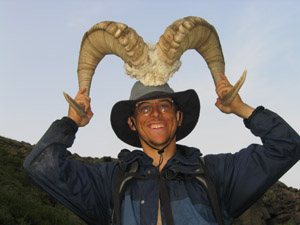
Grrrrrrrr!!! VIKING!!!
Most hats work fine. Warm thing on head, sort of woolly or fleecy, = warm head. Good hats are probably the easiest gear item to scrounge. We have a few tips:
- More Hats = Better. Hats are the only piece of clothing we all agree its good to have MULTIPLES of. Make sure you can stack them. Especially for sleeping, wearing 2-3 hats is very warm, but you don't want a compressed head.
- Layer for Effect. If it's wet or windy out, wear a waterproof or windproof hat or hood over dry hats beneath. No matter how much an advertisement claims something is warm when wet, water - unless it's hot water - always makes things colder.
- Choose the Right Material. A hat should be made of fleece, wool, or a similar fabric that is warm-when-wet and has vertical loft. Polypro hats may be problematic in very wet environments.
- Secure your Sleeping Hats. When sleeping with hats on, the topmost hat should have a chin strap of some sort, or your hats may migrate off your head in the night. Being a hot blooded species, most hats will seek the big puddle above your head for a cooling bath.
- Decorative Patches = Bad. Many sewn-on patches and embroideries hold water. The worst are cotton embroidered patches, which will stay wet and cold long after the rest of your hat is dry.
- More Coverage = Better. Low brims, ear covers, and even full balaclavas ("ski masks") are great. A big hat can be rolled down over your upper face when you sleep. A full balaclava should provide the option of leaving your mouth and/or nose exposed, or your breath will saturate it with water as you breath through it.
- A Hat should be Comfortable.
BEYOND SPEC'S FAVORITE SPECIALTY HATS:
The Fisherman's Sou'Wester. For REALLY wet places, this hat moves water off your head like nothing else.
The Home-Knit Big Wool Hat. Knit and/or get someone who loves you to knit a big wool hat that hangs down to your eyes and has earflaps. It will make you life good. Even better, make it spacious enough to wear a balaclava underneath it.
The Polypro Balaclava. This hat is a balaclava at its most minimal: a thin poly "ski mask" with a neck opening and a single large face opening with an elastic border. As such, it can be worn as a beanie, a neck warmer, a hood (with the full face exposed), or a mask with only the eyes exposed. It's very small and lightweight, easily rolling up in a pocket or purse, yet provides considerable warmth if it's dry. Being poly, when it gets wet it dries fairly quickly.
The Boonie Hat. The boonie hat is a wide-brim hat, often made of cotton. It's useful in dry and/or warm tropical climates as sun protection. It also breaks up the outline of your head. It rolls up, crushes up, and still works. The chief author found an old army surplus boonie hat at the 1999 Endfest punk/alternative rock festival, after it had been trampled by a drunken crowd. It's served him well ever since. Look in surplus stores for boonie hats.
Rain-Proof Home-Made Hobo Hats. You can make a rain hat with a brim easily out of gore-tex or treated nylon.
Other Commercial Rain Hats. Wide-brimmed commercial rain hats are also available. In wet climates, these can be extremely valuable, keeping underhats drier and preventing major heat loss through the head.
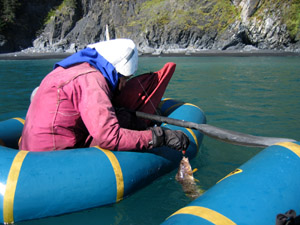
Beyond Spec's Culinary Icthyologist fishes from an Alpack in the Kenai Fjords, wearing the Magic Hat.
The Magic Hat. This technological wonder was first innovated by Bretwood Higman with a hot glue gun and closed cell foam. Basically, it is a cap made of closed cell foam and fitted with a chinstrap. It was later determined the duct tape is superior to glue in constructing it. The magic hat is very warm and completely waterproof and windproof, covering the head with a layer of foam normally used for sleeping pads. For cheapness, it's unsurpassed. For style, it's also unsurpassed, but in a different way.
Return to top.Gloves
There are more gloves out there than we can shake a stick at, but these are few
of our less conventional favorites:
- Neoprene. For hard wet-climate travel (think rainforest) these amphibious gloves are great. They're also tough enough to negotiate brush and rock.
- Atlas Semi-Rubberized Work Gloves. These are a good poor man's brush glove. The rubberized palm and fingers provide protection and a decent grip, while the pourous backside fabric allows the glove to breath. We don't know what the backside fabric is, but provides insulation even when it's muddy and soaking wet. Although nothing we've found matches bare hands for a good grip, we'd climb trees in these before any other glove. They lack the insulation and wind-proofing for skiing and other cold, high-wind endevours.
- Fingerless Woolies. These are great for keeping your hands warm and working with them at the same time.
- Fleece Gloves. Normal fleece gloves are warm, not too spendy, and easy to wring out when they get soaked. The fleece tends to flatten out if you're handling wet objects, and it's not windproof.
- Sox. For shear convenience, sometimes the old sock-on-hand method is king. If you don't need to use your thumbs, a fluffy sock may be the warmest hand covering there is, pound for pound.
Some of our less successful experiments include:
- Vaseline-doped Pigskin Driving Gloves. This experiment was extremely unsuccessful for temperate rainforest travel. The old pigskin gloves were too thin to insulate and protect well. The vaseline impregnation, intended to make them water resistant, was marginally successful at best. They just got cold and clammy, all the time.
- Cut-Down Heavy Leather Gloves. In Alaska once, we tried cutting the fingers and backs out of some old leather gloves to make brush gloves. Silly us. Going fingerless is great for warmth, but who really needs an armored palm?
- Home-Made Fleece Mittens. Don't get us wrong, these are great for snuggling in bed with, but we tried to use them for things like bushwacking and crossing exposed, wind-swept moors in Southern Alaska. They were wind-transparent and were more of a grip impediment than a hand guard.
Socks
The most consistent rule we've found for socks is that it's good to have two
pair: one for the day, one for sleeping in. In a cold climate, feet can lose a
lot of heat at night. No matter what our socks are made of, they're warmer when
they're dry.
- Wool Socks. Wool (or even better, blended wool-sythetic socks like Smartwool) are KING in most applications. They're passably warm when wet, and very warm when dry. If the environment is moderately wet, then the porosity of wool sox, when combined with well-draining shoes, periodically flushes your feet, too. This, in our experience, helps with foot health.
- Neoprene Socks. Neoprene socks are superb in very wet environments, where you're fording and wading a lot. In these places, the warmth is unrivaled. Neoprene socks are also fairly tough. We've walked around in just neoprene socks on rock and gravel. The chief author climbed to 17,000 feet in the Himalaya wearing just Teva sandals and neoprene socks on his feet, traversing scrub, rock, and snow-covered talus in driving wind and snow. When drying neoprene socks by a fire, be careful: neoprene burns easily, leading to very unfortunate holes. Keep in mind, also, that neoprene is an impermeable barrier: when wearing neoprene socks for long trips, we like to turn them inside out regularly. This puts a "clean" surface against our feet, and gives water and abrasion a chance to celan off the other side. Regularly drying them in the sun also helps, since foot-eating microbes don't like to be dried out and microwaved by the sun's UV light.
- Fleece Socks. Fleece socks look good on paper, but in actual use, the the fleece on the bottom compresses and forms a strangely unpleasant surface. They're fine as sleeping socks, but no better than wool, so we don't really see the point.
- Cotton Socks. Cotton socks are great in dry, civilized places, but they when they get wet, they get cold and they bunch up in a most unpleasant way.
- High Tech Snazzy Waterproof Socks. In our experience, super-swanky socks with things like gore-tex in them are a headache. When they're waterproof, we inevitably get water inside them, where it stays. Our feet sweat too much in them. They don't have the amphibious wonder-power of Neoprene. Since water doesn't flush through them, stuff starts to grow on our feet. Soon, thanks to the sand and grit in our shoes, they break down, and are no longer waterproof. Then they're REALLY great.
- Plastic Baggies. There's nothing shameful about wrapping your sock-clad feet in plastic bags and slipping them into you shoes, boots, etc., if you want to keep your feet dry for a not-so-intrepid adventure. Be forewarned that the plastic baggies suffer the same downsides as High Tech Snazzy Waterproof Socks, but if you're wearing cotton socks, it may be well worth using baggies and a little agility to stay warmer and drier.
- Wool and Neoprene Combination. When things get gnarly, wearing wool and neoprene socks together can be a wicked combination. We're still debating the merits of wool-under-neoprene (the lined wetsuit concept) or wool over neoprene (draining insulation over the wetsuit). We need to test it more. If you don't have neoprene and foresee a lot of time standing in cold water, you can try plastic baggies over wool socks. The plastic provides the impermeable barrier, and the wool provides the loft that neoprene normally would, albeit water-filled, in this case.
Footwear

Two pairs of otherwise identical Montrail Vitesse shoes.
We wear shoes and sandals, not boots, except for serious mountaineering,
skiing, and firefighting. Why?
- Load Size. Even on long trips, we seldom carry more than 40-50 pounds, including food and water.
- Agility. You are more agile in shoes. With the proper ankle conditioning, we believe this makes us less prone to hurt ourselves than if we wore boots.
- Weight. An old rule of thumb is that one pound on your feet is the equivalent of four pounds on your back. If you want to go far, or do it fast, lighter footwear seems to be easier on the body.
- Comfort. Shoes are more fun. Boots definitely have a place, but companies would have us believe that we MUST wear big boots always or we will DIE. We have yet to personaly experience these consequences.
We try to consider weight, durability, and comfort when looking at shoes. We also often use stability inserts, such as Superfeet, which minimize pronation (side-to-side rolling of the feet that can lead, among other things, to knee problems). You can find such inserts at any good running shoe store.
We haven't used most of the shoes out there. For that reason, the only actual models we discuss are our favorites, but we try to explain why we like them, so you can take our experience and assess the goods yourself. Besides, all our feet are different. Don't take our word for nuthin'.
Avia 2050 Running Shoes. The Avia 2050 is now discontinued, but exemplifies a good off-terrain shoe, suitable for alpine rock, snow, heavy brush, and river crossings. It featured an aggressive sole, a lot of torsional stability (resistance to twisting), and good, strong side edges, which were useful for kicking into snow and steep earth, and for edging on rock. The heal counter was similarly stout and sharp-edged along the sole, making it good for plunge steps on steep snow. Like almost all shoes, it had a flexible toe box, which wasn't much good for front-kicking up snow or standing on rock nubs. This failing, however, is the modest price of having an agile shoe that's pleasant to run and scramble in. Like almost all running shoes, the toe box also offered minimal protection to the toes. Either watch out for this, or accept that you'll toughen your toes. These are all usefull criteria to think about when evaluating any off-trail shoe.
Montrail Vitesse The Montrail Vitesse is of that new breed, the "trail runner." The Vitesse is a shockingly durable shoe compared to most of its brethren. It's unusually light and drains well. Like most trail runners, it offers more toe protection than running shoes, but at a slight cost in agility and speed. The big flaw of the Vitesse is that the cloth shoelace grommets can be abraided through if you're walking in a lot of dirt and muck. This is easily fixed by punching new grommet-holes in the top of the shoe.
Teva and Chaco Style Sandals. Many are the nice sandals out there, and we can't review them too much. Suffice to say that the chief author has used these sandals extensively in the desert and summer mountains, and got to 17,000 feet off trail in Asia wearing old Tevas. (We are not claiming he is bright, just stubborn.) The big weaknesses? Four:
- Some sandals secure via velcro. This velcro has a tendency to wear out too soon.
- In wet, muddy environments, the footbed can become VERY slick.
- Gravel likes to get in there, too.
- If you have heavily calloused or scarred heels, your heel can abraid through the webbing strap, necessitating repairs.
A sandals-and-neoprene-socks combination works well as a substitute for shoes.
Flip-Flops. With proper conditioning, we find flip-flops to be great for trail hiking. Flip-flops are light and flexible enough to allow the foot to move in a fairly natural fashion, conforming to the terrain and using small muscles. Plus, sun and fresh air feels good on our feet. It was Nepali farmers and porters who turned us onto this, wearing flip-flops while negotiating steep, slippery slopes in the monsoon with loads of 90 pounds our more. If they can do it, so can you. Rough off-trail travel, river crossings, and snowfields are not ideal places for flip-flops.
Wrestling Shoes. Wrestling shoes offer ground-feel with a modicum of foot protection. We were turned onto wrestling shoes by the folks at Tom Brown's Tracker School. For those who like to photograph, hunt, or just watch animals, wrestlings shoes offer much of the silence of mocassins.
Heavy Sox. Heavy sox can be great for easy terrain or trail hiking when it's cold out. 2 pair can provide significant insulation.
Mocassins We have yet to try mocassins ourselves.
A NOTE ON KEVLAR LACES: In a world without dirt (such as Los Angeles?), Kevlar laces are a great idea. Kevlar is vulnerable to abrasion, falling apart when ground upon by grit. Those who live in a world with dirt are advised to steer clear of laces that disintegrate after 300 miles.
Pants
Traditionally, "pants" and "rain pants" are separate
categories. Bollocks, we say! How often have you worn your so-called "rain
pants" on a dry day? How long have you froliced in the rain in *gasp* non-rain
pants? Free yourself from the tyranny! We hold true that they're ALL
trousers, meant to provide the protection to the legs. A few general rules about pants:
- Seams Rip Out. Seams are the weakest point of your pants. Especially on rainpants, Seam-seal all the stitch lines our rainpaints with SeamGrip or a similar urethane sealant. The crotch is a particularly weak point. Look for gusseted crotches if you have to do a lot of climbing, bushwacking, or other gymnastic moves.
- Less Seam Lines = Better. The fewer seems your pants have, the fewer weak points they have. This is especially true on the front of the pants, where they take more abuse.
- Consider the Waist Cinch. Is it a tie-off waist, requiring dextrous fingers. Its it a simple toggle-cinch, which is easier, but can grind into your stomach over time, especially if worn under a harness or waist belt? If velcro holds the waist band tight, will you spend large amounts of time in muddy environments, where that velcro might foul? Or does it accommodate a belt, and thus sit more securely on your waist, and also introduce a buckle that might be a real problem?
- Rivers Grab Loose Material. The more loose material is on your lower legs, the more force a flowing river will exert on you during a crossing. Furthermore, any opening (such as a baggy cuff) or irregularity creates more surface for water friction. Rough fabrics (such as wool) create more water friction than smooth fabrics (such as nylon.)
- Droopy Cuffs are Doom, Doom, Doom! A droopy cuff of city pants is easy to roll up, or just fray under your heel. With a brush pant, it can be a lot worse. It invites snagging on brush and impaling by crampons, which can happening at extremely unfortunate moments.
- Leg Zippers are a Wild Card. Full length leg zippers can be handy for donning pants without removing your footwear, but they better be durable and water-resistant. These make the pants heavier, and – if they do fail – leave you with a real mess. Some people like shorty calf-high zippers, which open the lower leg just enough to let you put the pants on over boots. Although these haven’t caused us any woe, we don’t find ourselves using them much, either.
- Rough Material Sticks; Smooth Material Slides. Pants of wool and other rough material will not slide as easily on steep snow, grass, mud, and other slippery surfaces. This can be an asset or a weakness, depending on your application.
BEYOND SEPC'S SPECIFIC PANT THOUGHTS:
Rainpaints. There are a lot of super-spiffy rain pants and/or waterproof ski pants out there, made of everything from treated nylon to the latest waterproof-breathable fabric. We adhere to some general rules:
- You Sweat when Walking. The harder you walk, the more your legs have to dump excess metabolic heat. Any sweat trapped gets cold and clammy once you stop. It also saturates anything you have on underneath your pants. Consider waterproof-breathable pants if you walk hard and then stay out there. Alternately, wear very little under your treated nylon rainpants, then switch into insulated pants once you stop walking.
- Layering is Better than Integrated Insulation. Unless you plan on buying multiple pairs of wet-weather pants, stear clear of ski-style pants with integrated insulation. You can get just as much warmth by layering fleece or wool pants under your rainpaints, plus greater versatility and ease of repair.
- Brush Shreds Rainpants. Heavy bushwacking will eventually destroy your rainpaints unless they're foul-weather-gear weight. No matter how many reinforced cuffs, knees, etc., you have, the devil's club and himalayan blackberry will eventually win. Consider buying cheaper pants.
- Gaiters are “Disposable” Lower Leg Armor. You can wear gaiters over your lower legs, especially if you bushwack a lot. Gaiters are easier to fix and cheaper to buy than whole rainpants. Use them to absorb the punishment.
- Rain Pants are Slick. Rain paints will slide on steep snow and vegetation, whereas fabrics like wool are stickier. Consider whether this is a problem.
- Rain Pants are Loud. Most rain paints have some sort of nylon exterior, which makes a loud, distinctive whistling or sliding sound.
Brush Britches. A pair of
rainpants (or any other pants) can also be transformed into "brush britches," for those
who face lots of river crossings in open terrain, or simply have a callous
disregard for their own shins and calves. To make brush britches, just cut off
an old pair of rainpants at mid-calf. Even when kneeling, they should still
protect your knees. This creates a well-ventilated, agile pair of britches that
drain quickly, don't get soaked in shallow streams, and don't snag at the cuffs
on brush.
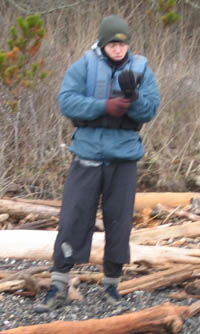
Classified CIA archival photograph of brush britches during amphibious operations in the San Juan Islands, or possibly
Turkmenistan. Note the duct tape patching, heavy wool sox, trail shoes, PFD, raingear, and hat-over-balaclava.
Foul Weather Gear. "Foul Weather Gear" is used here in the nautical sense, refering to VERY heavy, totally impermeable rain bibs. These are great if you're in a storm at sea, but we find their heaviness, stiffness, and resulting spacious fit unsuitable for trekking, bushwacking, and climbing. Of particular note: the fit results in poor insulation.
BDUs (a.k.a. Army Pants). We are still collating data on BDUs.
Fleece Pants. Fleece pants can be great, but they don't offer nearly as much protection as they offer warmth. We discuss insulation under Body Insulation, below.
Woolies. Wool pants are great. They're fire-resistant, quiet, and warm even when wet. They can also be scratchy. Army-Navy Surplus stores can be a good place to look for wool pants. King of the Mountain makes great wool products, including pants, but they're also EXTREMELY expensive.
We don't have as much experience with wool pants as we'd like.
Nomex. Nomex-treated forestry pants are lightweight, tough, slightly warm, and dry fairly quickly. They're available in dark green, and some versions have large cargo pockets as well. They're fire resistant, but also slightly abrasive. If you're doing a lot of fire-camping in a hot, dry climate, nomex can be great. They can also be expensive: up to $80, or - for the tan ripstop kevlar ones - $120 or more. Note, also, that the Kevlar ones will break down much more quickly, due to Kevlar's abrasion vulnerability.
Nomex pants may be useful in warm climates if you’re working with fire a LOT. Otherwise, there’s not much reason to wear them. If you want nomex, we recommend the "Crew Boss" pants. Avoid "wrangler" style at all cost if you're a man.
Jeans & Carharts. Denim or canvas work pants can be great in hot, dry climates as long as you take care not to get them wet when it's cold. In situations where we might have to bivouac or might endure a thundersquall or river-crawl followed by cold, we avoid these pants like the plague.
Raingear
We think if very general terms about raingear, even though we wear it a
lot. There are roughly 10.7 Billion different raincoats out there, and in our
collective experiences, the differences between the Super-Gonzo Zazzagucci Tech
X-9000 Anti-Water System and Honest Bob's Nylon Slicker aren't as big as the
$400 price difference would have us believe. If you're traversing mountains,
forests, and sub-arctic plains in driving wind and rain, no matter what you
wear you WILL get at least a little WET.
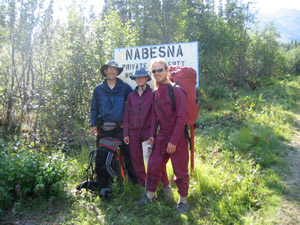
Raingear Arrangements. Left: Beyond Spec's Bioweapons Expert in the traditional coat-pants combo.
Right: Two Beyond Spec Operatives (Identities Confidential) in home-made unibody rainsuits.
BEYOND SPEC'S RAINGEAR THOUGHTS
- Super Lightweight Raingear. Super light stuff-in-your pocket raingear is nice for the desert (were it serves more often as windbreaker), the city, or mountains where you *really* don't expect much weather. If you plan on doing any serious scrambling or bushwacking in it, it probably won't last more than a few days.
- Waterproof-Breathables vs. Treated Nylon. Treated nylon is cheap, hardly breathes, and holds up longer than gore-tex and other waterproof-breathable fabrics. The W-B fabrics breathe, allowing you to eliminate more moisture from beneath it, but will wear out more quickly, losing its waterproof qualities. Note, also that there's a big difference between cheap w-b fabric and expensive w-b fabric, even under the same brand name (like gore-tex). If you want to go nylon, go for it. The chief author's only raincoat is treated nylon. Understand, however, that you'll have to spend a little more energy on clothing management if you want to avoid sweating up a micro-swamp under your coat.
- Foul Weather Gear. Helly Hansen and other companies make some great heavy-duty raingear that's cheaper than gore-tex and tougher than god, but heavy as hell and not well suited to hiking at all. This "foul weather gear" may have a good wilderness role, but we've only found heavy use for the Sou'wester Hats.
- Pit Zips let water in if you raise your arms a lot. They’re also a source of heat loss, even when closed.
- Hoods are a more effective alternative to a rain hat, but they drasticaly reduce your environmental awareness.
- Length. A raincoat that rides up above your waist when you raise your arms is a recipe for a cold, wet crotch and bum.
- Waist Cinch. An elastic cinch around the waist keeps you much warmer, limiting air circulation when you move. It also helps prevent water circulation, and - if you're using your air mattress as a life preserver, it helps to secure it.
- Wrists Closures. Velcro tighteners work well, although they do hold some water. Elasticized wrists can get aggravating if they're too tight. The best option we've found is to actually sew the sleeves so they're a custom, snug foot over your wrists. They limit air circulation and water penetration as well as giving your wrist and forearm a smoother profile.
- Bells & Whistles Neat-o pockets and vents and such can be pretty cool when we're skiing and such, but in the middle of nowhere when we've just fallen in the river and its raining and we're trying to build camp in wet ferns, all we really care about is having an intact waterproof membrane over our body, keeping the warm stuff - our body insulation - from exchanging too much air and water with the outside world. That's what it comes down to. Speaking of which...
- Don't burn holes through your raingear or impale it with your ice axe. Not that we've done either. Or both.
Do-It-Yourself Raingear.
Some of us prefer to make our own raingear, or to improvise it.
- To use your spaceblanket as a quickie poncho, see Space Blankets.
- For garbage bag raingear, see "garbage bags" in the improvised gear section.
- Rainsuits: At this time, the Building Gear Section is under construction.
Body Insulation.
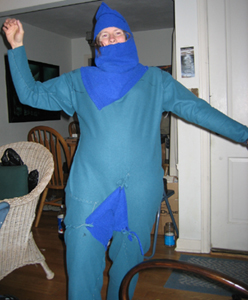
Beyond Spec's Runway Diva models this year's "in" unibody fleece suit w/ integrated hood.
Body insulation is the warm clothing on your body extending out to the neck, wrists, and ankles. Unless we're someplace very cold, covering our lower legs and forearms is not nearly has important as insulating our knees, elbows, hands, and feet. For this reason, "shorty" garmets can be very excellent insulation when negotiating wet brush.
Note that signficant heat loss occurs wherever clothing separates, such as at the waist line between coats and pants. For this reason, unibody suits - such as we sometimes make - are superior insulators to two-piece outfits.
BEYOND SPEC'S BODY INSULATION GUIDELINES:
- Fewer Separations = Warmer
- Fewer Zippers = Warmer
- Baggy = Too Much Air Circulation. Baggy clothes require that your body heat more air to stay warm, and your movement can have a bellows effect, forcing circulation of that trapped air, thus cooling you.
- Know the Critical Coverage Areas. Covering the head, neck, torso, armpits, and crotch is most important.
- Joints Get Cold. Joints have less blood flow and insulating muscle and fat. For that reason. If you're making a shorty garmet or cutting something down, consider ending it just beyond the knees and elbows.
- Pockets are nice if they're in your outer garmet, but otherwise they're not of much use. Consider the pocket designs: many are made without much thought to thermal efficiency. A pocket you never use is a hole in your clothes with a decorative zipper.
- Windstopper. Windstopper fleece doesn't do you any extra good if you're wearing a windbreaker over it, and it holds water like a Beluga whale. Nor does it do you any good when, after a couple years, it disintegrates and forms shredded clumps of material along your coat’s hem line.
- Wrists. You can lose heat out the ends of the sleeves if they aren't snug enought. Consider button cuffs, elastic, or simply modifying the sleeves so that they're fairly snug along the wrists and forearm.
- Hem Line. A garmet that rides up your belly when you lift your arms is going to cost you a lot of heat loss, especially when it’s raining sideways.
- Little Heat Losses Add Up. Heat is like weight: One thermal inefficiency isn't much, but when you add ten of them together, you're losing a lot of heat.
- Wet = Cold. No matter how something is advertised, it is colder when it gets wet. Your body is now heating water as well as the garmet material and the air trapped inside it. Water has about 200 times the heat capacity of air. When you do get wet, thick fleece & wool are the best materials to be wearing. See Understanding Gear Design.
The Capilene Base Layer Question. Conventional wisdom seems to hold that it's always better to have some sort of thin, "wicking" base layer of capilene. The idea is that it wicks moisture "away" from you, and the moisture - a la the magic of wicking - then evaporates quickly. his is sort of funny, since our experience is that a very thin, wicking garmet spreads moisture laterally, since it lacks the loft to move it away from your skin. Then, if you're in a dry climate with good air circulation, the water evaporates. If you're in, say, a temperate rainforest during a drizzle and you're wearing raingear over your magic capilene undies and bushwacking through heavy thickets, capilene underwear doesn't work so well. It wicks water and sweat all over you, but it doesn't evaporate. No, the garmet stays wet, and makes you colder.
For this reason, when we're in very wet environments, we prefer to wear fleece against our skin. Fleece wicks moisture vertically as well as horizontally, moving it away from our skin. Furthermore, fleece drains well and has enough loft that, even after full immersion in a river, it's warming us within minutes.
Merino Wool. We’ve got 2nd-hand testimony from a couple fellas who climbed Denali (McKinley), and rain into the same capilene-underwear problem. They also had lightweight merino wool underwear, and wore that – in great comfort – for the entire trip. They found it was warm, even when soaking wet. Wool is, after all, magic. It’s got that sheep mojo goin’ on. Nonetheless, we have not verified this. Merino wool is expensive.
The Fleece Body Suit. The Fleece Bodysuit is the king of wet climate body insulation, in our somewhat deranged experience. Since the Building Gear section isn't written, we refer you to Erin and Hig's Alaska Trekking Page, where Erin showcases last season's stylish model.
Coats & Shirts. Any coat or shirt of insulating material obviously adds warmth.
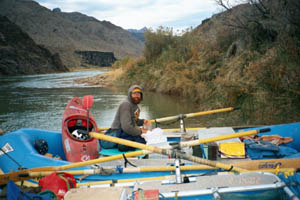
Beyond Spec's Heinousness Epert wears a cotton hoodie on the Colorado in January. As long as he stays dry, cotton's killer!
Vests. A vest adds a great deal of body core insulation at less weight than a full coat, but often leaves something to be desired at the armpits and collar. If you want to carry a vest instead of a coat, you may consider adding short sleeves. Currently, we're looking into fabricating a short-sleeved, high-collared pullover tunic to fill this role.
Fleece Boxer Shorts. In our demented little world, these are strictly homemade contraptions, and they're invaluable. Our fleece shorts are short (think runner shorts), close but not snug (loose fabric wastes warmth), and are outfitted with a tie-off drawstring at the waist. The important thing is to have your crotch and high inner thighs insulated. Thanks to this coverage, they provide much of the effect of full-length fleece pants at a fraction of the weight. The chief author even skis in fleece shorts and rain pants, only occasionally adding long underwear beneath them.
IMPROVISED INSULATION.
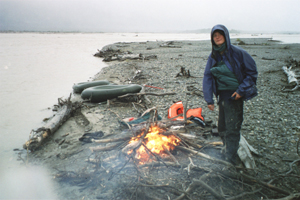
Warming up on the Alaska Peninsula. Note the sleeping bag around the chest.
Hypothermia is more likely to kill you than sharks, bears, wolves, cougars, wombats, and meteors combined. If times are tight (or cold, as it were), you can employ several quickie insulation solutions:
- Layer All Dry and/or Warm-When-Wet Insulation. More insulation = warmer.
- Stuff Your Shell. Stuff leaves, moss, crumpled newspaper, or other insulating materials inside your outer clothing, creating more loft. Dry stuffing is best. Damp stuffing is usually OK; sodden stuffing = not so good. Experiment.
- Discard Heat Sinks. Stow your ice axe, rifle, or any other metal objects. Remove crampons, which conduct heat right from your feet into the ice. If you have to urinate, etc., do so: bio-waste is a heat sink in your body. Urination in the cold is a survival strategy: your body is dumping liquid to reduce the volume it must heat.
- Eat & Hydrate. This is a balancing act: if you're well fed and hydrated, your body is running at higher performance, and can heat you better. Drinking quart after quart of icewater, however, will cool your core, since your body must heat it.
- Minimize Loft Compression. Loosen belts and harnesses. Take off your pack. Loosen tight shoes. Anything that compresses your loft reduces your insulation.
- Hood Up. Pull your hood over your hats and cinch it, creating your own head-space micro climate.
- Wrap Your Core. Wrap sleeping bags, foam pads, mattresses, empty packs, or other items around your chest or torso to further insulate you. If you're stationary, you can expand this to the rest of your body.
- SHELTER UP!!! Stay out of the wind and rain. Stay off metal or sodden, well-conducting surfaces like wet sand. Hunker down on a duff layer. A rock is usually better than bare soil, and bare soil is better than a puddle. Share body heat. If you have a bivy sack, use it. If not, wrap in a space blanket, stick your legs into your pack, or snuggled up in a garbage bag. If you have a parachute, fold it multiple times over yourself, trapping air in the folds. Real men would rather share a bivy sack with another man than freeze to death.
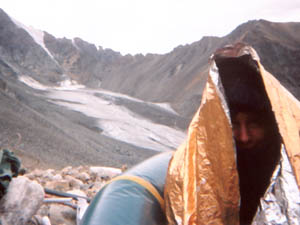
Beyond Spec's Common Sense Technician hunkers like an intelligent coward
in a light space blanket and an Alpacka Raft on the 2004 Alaska Wilderness Classic.